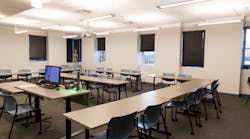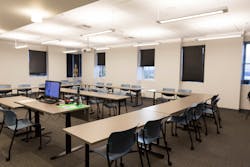Luminaire level lighting controls (LLLCs) have the potential for significant energy cost savings. Although the numbers vary by facility type and hours of operation, the average savings is up to 63% beyond fixture upgrade savings alone, according to a recent report from the Northwest Energy Efficiency Alliance and the DesignLights Consortium titled, “Energy Savings from Networked Lighting Control Systems With and Without Luminaire Level Lighting Controls.”
With LLLCs, each fixture has its own built-in sensor, enabling wireless communication and data transmission. Users also can group and regroup lighting as needed, down to the individual fixture level (often with a tablet or smartphone app).
But how well do they work in the real world? What are some of the challenges and best practices as building owners prepare to make the switch? Here are two examples of lighting retrofits using LLLC technology to put energy and cost savings into perspective for building owners.
South Lander Business Park
South Lander Business Park in Washington state has a wide variety of tenants — from small offices to large warehouses. The owners knew they needed to upgrade their outdated fluorescent lighting and were initially attracted to the adaptability and cost-efficiency of LLLC systems.
Instead of a wholesale upgrade across the entire property, they first tested the technology in smaller tenant spaces. Over time — and after receiving incentives from Seattle City Light — they were able to install an LLLC system in several mid-sized warehouse spaces and eventually in a 30,000-sq-ft warehouse space (the largest of the business park’s tenants).
Thanks to these upgrades, South Lander can now create zones to prevent having all warehouse lighting on at the same time and avoid costly wiring work when there is tenant turnover. In the first year alone, the large warehouse space saved $7,500 on its utility bills. Facility managers are also seeing huge savings in maintenance costs — going from several thousand dollars annually down to almost zero.
“Energy and maintenances costs are the top two reasons to install LLLC systems, in addition to overall better quality of light,” says South Lander Business Park Owner Joe Mitter. “In almost all cases, I would tell people to spend the extra amount for controls because they give you so much future flexibility. We’re future-proofing our lighting for the next 15 to 20 years.”
Pacific Tower
Similarly, Seattle’s iconic Pacific Tower, which was originally built in 1932, needed system upgrades to both modernize the building and conserve energy. The building serves a variety of tenants, from the Washington Department of Commerce to Seattle Central College’s dental and nursing school laboratories, each of which has varying lighting needs. This was why an LLLC system was the ideal solution to customize lighting in different parts of the building to best serve occupants and provide flexibility.
The granular data provided at the fixture level also allowed Pacific Tower’s owners to achieve aggressive energy savings. For this project, 2,000 fixtures were installed, and the building saw 80% energy savings compared to the previous system. By partnering with the local utility, building managers also received both technical assistance on the project and significant incentives to help offset upfront costs.
Now, the building’s lighting energy use is 27% better than Seattle’s already progressive energy code.
One key recommendation from the project engineer: Take into account the cumulative cost effectiveness created by the technology and equipment you are considering. Installing LED fixtures with integrated sensors such as LLLCs is a high return-on-investment measure that can significantly cut down the time it will take to achieve payback.
Wolgamott is senior product manager for the Northwest Energy Efficiency Alliance. He can be reached at [email protected].




